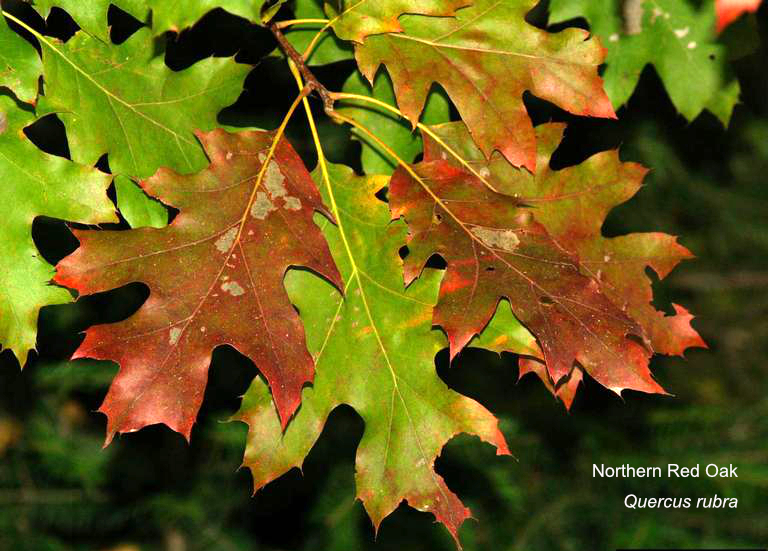Natives to Know: Michigan Oaks (Quercus, sp.)
By Joyce Tuharsky, WORC Member
A mature oak tree is magnificent organism to behold. With their wide impressive canopy and massive, often gnarled branches, oak trees can live for centuries, reaching heights of 160 feet or more. No wonder oaks have been objects of legends dating back to ancient civilizations …. Greeks, Romans, Celtics, and native Americans.
In more recent history, oaks have been prized for their sturdy, thick wood that is great for making things: railroad ties, mining timbers, hand tools, furniture, interior trim, flooring, musical instruments, and barrels in which to age whiskey, brandy, and wine.
But perhaps the oaks’ greatest feat is their ecological services. Doug Tallamy has written that oaks provide food and shelter for more life-forms than any other tree genus in North America, benefitting creatures large and small—from bear and deer to squirrels, racoons, turkeys, songbirds, and countless insects, spiders, and caterpillars. Oaks can produce 3 million acorns in a lifetime providing wildlife with valuable protein, fat, and carbohydrates. Each year, one oak can drop up to 700,000 leaves that decay to support important soil organisms. With their massive canopies and root systems, oaks help purify water, provide temperature moderating shade, and sequester carbon.
Autumn is here, and there is no better time to enjoy the beauty of oak trees in Michigan. When identifying oaks, the first thing to know is that all oaks fall into two broad groups: red oaks which have leaves with pointy bristle-tipped lobes, and white oaks which have rounded lobes or large, wavy teeth along the edges. Interesting fact: Acorns of red oaks take two years to mature, while acorns of white oaks mature in only one year!

Below is a brief description of some the more common oak species in Michigan:
Northern Red Oak (Quercus rubra) – grows to 90 feet tall, 2–4 feet in diameter. Fast-growing, these trees can reach a height of 20 feet in the first 10 years and live up to 400 years. The leaves are 5–8 inches long, dull green above and paler below; with 7–11 shallow, bristle-tipped lobes that are irregularly toothed. The sinuses reach about half-way to the midrib. The acorn is about 1 inch long, egg-shaped with a flat, thick beret-like cap that covers 1/4 of the nut. Mature trees are distinguished by long vertical strips of smooth bark that look like light striping going up and down the trunk.
Black Oak (Quercus velutina) – grows to 80 feet high, 35 inches in diameter. The leaves are leathery in texture, 4–10 inches long with 5–7 bristle-tipped lobes, dark green above, pale yellow-green below often with brown hairs. The acorns are ¾ -1 inch long, elliptical in shape, ½ covered by deep thick caps with a border of fringed loose scales. The bark is rugged and fragmented with horizontal cracks. This tree is distinguishable by its yellow-orange inner bark.
The leaves of black oaks and northern red can be difficult to tell apart. The leaves of black oak are shiner and generally have fewer lobes than those of northern red oak. The texture and color of the bark differ for these trees.
Northern Pin Oak (Quercus ellipsoidalis) – grows to 70 feet tall, 35 inches in diameter. The leaves are 3–5 inches long, widest in the middle, with deep round sinuses, a flattish base, and 5–7 bristle tipped teeth. The acorns are about 3/4 inch long and have caps with loose, fuzzy scales that enclose 1/3 of the nut. This tree has a short trunk and many small branches, tending to hang onto lower branches as they die.
White Oak (Quercus alba) – grows 80–100 feet tall, 3–4 feet in diameter, and lives 200–300 years. The leaves are 4-8 inches long, with 7–9 rounded, finger-like lobes. The leaf is widest above the middle with sinuses that vary from shallow to deeply cut. The apex is rounded and the base is wedge-shaped. The acorns have warty, light gray caps, covering about 1/4 of an oblong nut. The ashy gray bark color helps to distinguish white oak from other oaks species.
Bur Oak (Quercus macrocarpa) – grows typically 80 feet tall (but known reach 150 feet), 2–4 feet in diameter. It is one of the slowest growing oaks, commonly living 200–300 years, known to live 400 years. The leaves are 3–6 inches long, broadest above the middle, with the lower half divided by 2–3 lobes on each side, the center sinuses reaching nearly to the midrib, and the apex broad with wavy edges. The acorns are the largest of our native oaks, with deep-fringed caps enclosing more than half of the nut. The Bur Oak is our only native oak to develop corky ridges along its branchlets.
Swamp White Oak (Quercus bicolor) – grows 60–80 feet tall, 2–3 feet in diameter. It is a lowland tree often found along lakes and floodplains. The leaves are 4–7 inches long, broadest above the middle, with a rounded apex, wedge-shaped base, and 5–10 shallow large irregular rounded wavy teeth along the edges. The acorns are borne on long stalks with deep bowl-shaped, spiny caps covering about 1/3 of the nut. This tree has a narrow, rounded crown, with lower drooping branches. The dark brown bark along the branches often peels off in papery curls (sycamore fashion); no other oak has this characteristic.
Color photo: Becca MacDonald, Sault College, Bugwood.org
Leaf illustrations: Joyce Tuharsky
Bibliography:
Grimm. (1962). The Book of Trees, Stackpole.
Little. (1980). The Audubon Society Field Guide to North American Trees. Alfred A. Knopf.
Wilson, Marcy. (Aug. 11, 2021). Identifying the Oaks of Michigan, Gardening in Michigan. MSU Ext.
6 Common Types of Oak Trees in Michigan. ProGardenTips. https://www.progardentips.com/oak-trees-in-michigan/
Tallamy. (2021). The Nature of Oaks: The Rich Ecology of Our Most Essential Native Trees. Timber Press.

